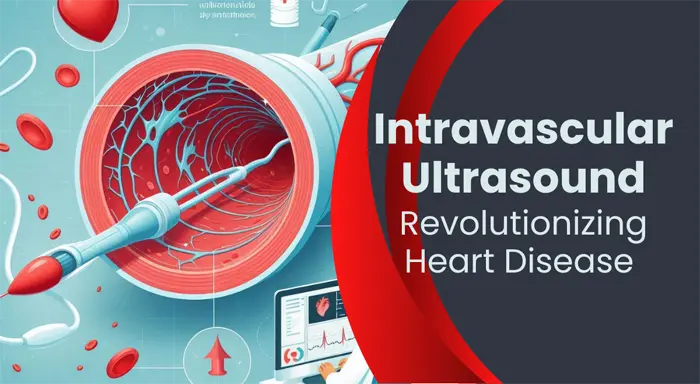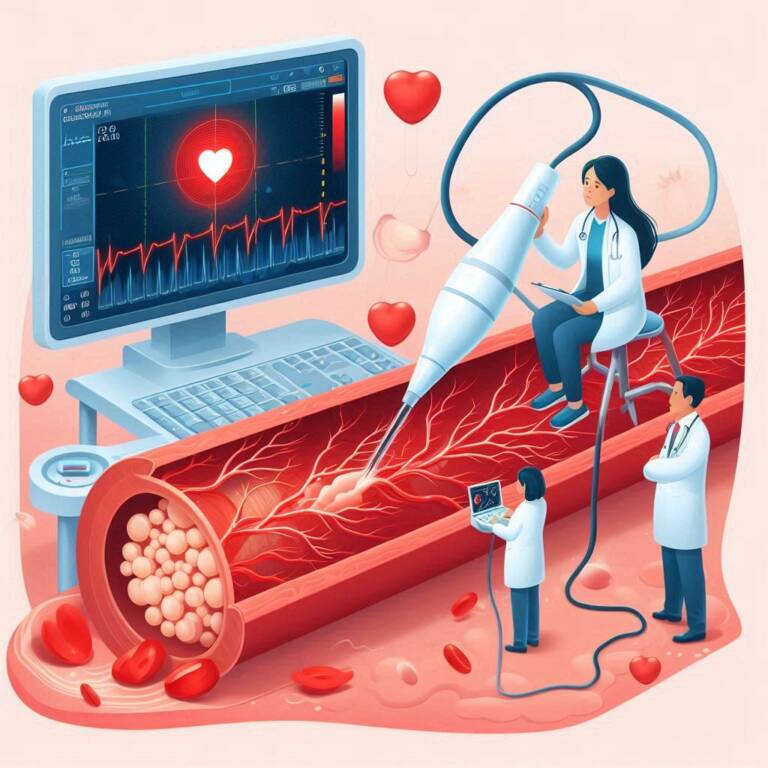
Introduction to Intravascular Ultrasound
Intravascular Ultrasound, or IVUS for short, is like a special camera that doctors use to see inside your body’s pipes, called blood vessels. Imagine you’re playing a video game, and you have a map that shows you all the hidden tunnels and rooms. IVUS is kind of like that map, but for doctors.
When doctors want to check if these blood vessels are healthy or if there’s something blocking the way, they use IVUS. It’s a tiny tube with a camera that goes inside the blood vessel and takes pictures all around it. This helps doctors see if there’s any buildup, like plaque, which can make it hard for blood to flow.
The camera works by sending out sound waves that bounce back and create a picture, just like how a bat uses sound to see in the dark. This picture helps doctors understand what’s happening inside without having to open the body.
Using IVUS, doctors can make better decisions about how to treat problems in the blood vessels. It’s a super helpful tool that makes sure patients get the care they need without any guesswork.
Table of Contents
Historical Evolution of IVUS Technology
Intravascular Ultrasound (IVUS) is a cool tool that doctors use to see inside our blood vessels. It started in the 1970s with simple images. Over time, as technology got better, so did IVUS. Now, it gives doctors super clear pictures, helping them treat patients without big surgeries.
Principles of IVUS Imaging
IVUS is a bit like a superhero gadget that lets doctors see inside your blood vessels.
Here’s how it works, in simple words:
- Tiny Tube: IVUS uses a small tube that can fit inside your blood vessels.
- Sound Waves: This tube sends out sound waves that are too high-pitched for us to hear.
- Echo Pictures: When these sound waves hit something, like the wall of a blood vessel, they bounce back. The IVUS machine catches these echoes and turns them into pictures.
- Inside View: These pictures show what the inside of the blood vessel looks like, kind of like how a camera takes a photo of what’s in front of it.
- Safe and Sound: It’s a safe way to check blood vessels because it doesn’t use any cuts or x-rays.
Advancements in High-Definition IVUS
Intravascular ultrasound (IVUS) has gotten a big upgrade with high-definition (HD) technology. It’s like going from a regular TV to an HD TV, where everything looks clearer and sharper. Here’s what’s new:
- Clearer Images: HD IVUS shows much clearer pictures of the inside of blood vessels. This helps doctors see tiny details they couldn’t before.
- Better Decisions: With these clear images, doctors can make better choices about how to treat patients.
- Quick Learning: The HD pictures are so good that doctors can understand what’s going on inside the blood vessels quickly.
- Safe Checks: Just like standard IVUS, the HD version is also safe. It doesn’t need any cuts or harmful rays to work.
So, with HD IVUS, doctors have a powerful tool to help them take even better care of our hearts and blood vessels!

Clinical Applications of IVUS
Intravascular ultrasound (IVUS) isn’t just a cool gadget; it’s a superhero tool that helps doctors in many ways. Here’s how IVUS is used to keep us healthy:
- Spotting Blockages: IVUS can find where blood vessels are blocked, which is important for treating heart problems.
- Checking Plaque: It helps doctors see the plaque, a sticky stuff that can clog blood vessels and cause heart attacks.
- Guiding Stents: When doctors need to put in a stent, which is like a tiny tube to keep blood vessels open, IVUS helps them place it just right.
- Evaluating Success: After treatments, IVUS checks to make sure everything is working well inside the blood vessels.
- Research: Doctors also use IVUS to learn more about heart diseases and find better ways to treat them.
So, intravascular ultrasound is a key player in making sure our hearts and blood vessels are in tip-top shape!
IVUS in Coronary Interventions
It is super helpful when doctors work on the heart’s blood vessels, known as coronary interventions. Here’s how intravascular ultrasound (IVUS) plays a big role:
- Seeing Inside: IVUS lets doctors see the inside of the heart’s blood vessels in real-time, like a live video.
- Helping with Stents: It guides doctors to place stents perfectly. Stents are tiny tubes that help keep blood vessels open.
- Measuring Stuff: IVUS measures how big the blood vessels are and how much plaque is inside, which is important for treatment.
- Making Sure: After a stent is in place, IVUS checks to make sure it’s sitting just right and the blood vessel is nice and open.
- Avoiding Problems: It helps doctors avoid any issues during the procedure, keeping the heart safe.
Comparative Analysis: IVUS vs. Other Imaging Modalities
When doctors want to look inside our blood vessels, they have a few tools to choose from. Intravascular Ultrasound (IVUS) is one of them, and it’s cool because it uses sound waves to create pictures. But there are other tools too, like OCT (Optical Coherence Tomography) and angiography. Let’s see how IVUS stacks up against these:
- IVUS: It’s like having a tiny echo-location device that can show doctors what’s inside the blood vessels. It’s good at showing how big the vessel is and if there’s any plaque.
- OCT: This one is like a super-detailed camera. It can take clear pictures of the blood vessel walls, but it can’t see as deep as IVUS.
- Angiography: Think of this as a basic map of the blood vessels. It shows where the paths go but doesn’t give much detail about what’s inside.
IVUS is great because it can see deeper than OCT and gives more info than angiography. But sometimes, doctors might use OCT if they need a super clear picture of the vessel wall or angiography for a quick look at the blood vessel paths.
So, IVUS is a handy tool for doctors, especially when they need to know more about what’s happening inside our blood vessels!
Challenges and Limitations in IVUS
Even superheroes have challenges, and so does intravascular ultrasound (IVUS). Here’s a look at some of the hurdles IVUS faces:
- Seeing Clearly: Sometimes, IVUS can’t see very clearly through very hard stuff in the blood vessels, like calcium.
- Tiny Details: IVUS might struggle to show really small things, like the thin cover over plaque 1.
- Cost: IVUS is amazing, but it can be expensive, which means not all hospitals might use it.
- Time: Using IVUS can make a doctor’s work take a bit longer.
- Special Training: Not all doctors know how to use IVUS. It’s like needing a special driver’s license to drive a fancy car.
Future Directions in IVUS Technology
The world of intravascular ultrasound (IVUS) is always advancing, bringing new possibilities to healthcare. Here’s what we might expect in the future:
- Enhanced Imaging: Researchers are working on improving IVUS images to give even more detail and clarity.
- Integration with Other Technologies: IVUS may be combined with other medical imaging methods to provide a more comprehensive view.
- Miniaturization: IVUS devices could become smaller, making them easier to use in a wider range of procedures.
- Speed: Future IVUS systems may operate faster, reducing the time needed for procedures.
- User-Friendly: Advances may make IVUS simpler to operate, allowing more healthcare providers to use it effectively.
These developments aim to enhance patient care, making Intravascular Ultrasound an even more valuable tool in medicine.
Conclusion: The Impact of IVUS on Patient Care
The advancements in medical imaging, particularly with Intravascular Ultrasound, have revolutionized the treatment of heart conditions. By providing a safer and non-invasive means to examine the heart, this technology ensures a more comfortable experience for patients. The precise images obtained guide doctors in making accurate diagnoses and effective treatment plans, leading to improved long-term health outcomes. It stands as a significant achievement in the field of medical diagnostics, underscoring the importance of continuous innovation in patient care.
- Better Treatment: IVUS helps doctors make smarter choices about treating heart issues.
- Seeing the Unseen: It shows what’s going on inside blood vessels, which can be hard to see otherwise.
- Safe and Sound: IVUS is a safe way to check the heart, without needing big surgeries.
- Long-Term Health: Using IVUS can lead to better health for a long time, even more than a year after treatment.




2 Comments on “Intravascular Ultrasound: Revolutionizing Heart Disease Diagnosis”